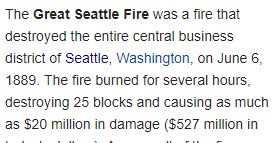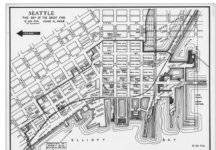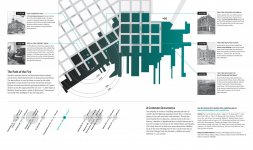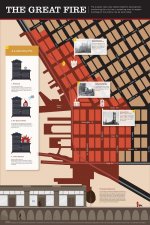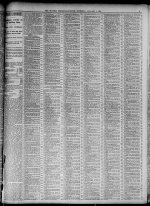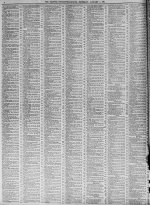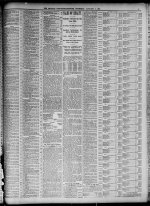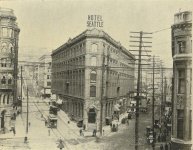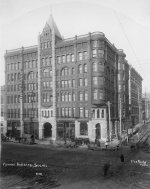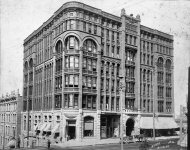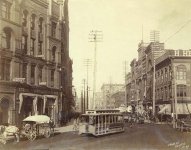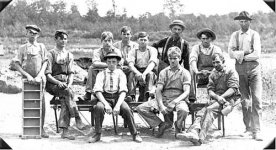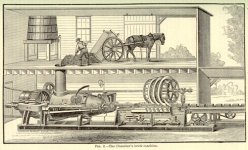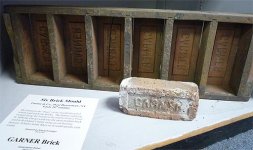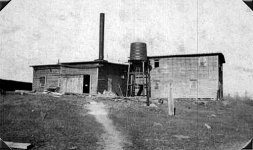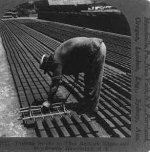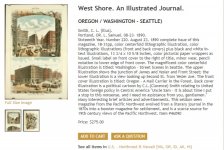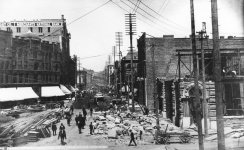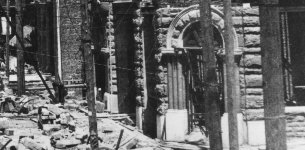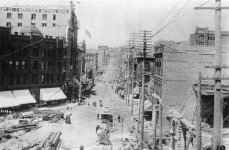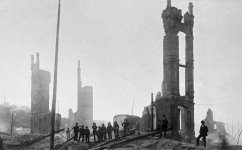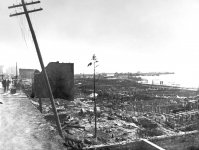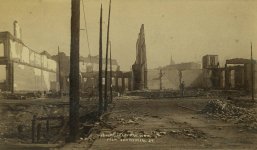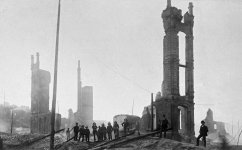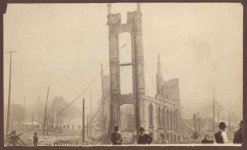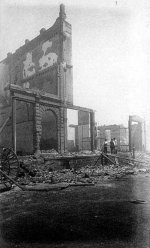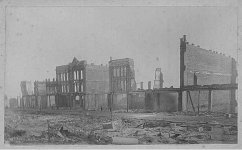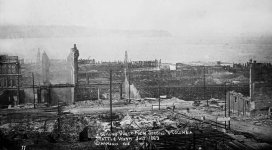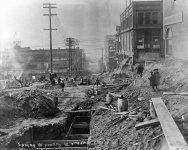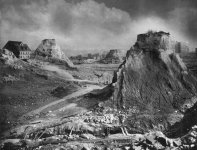There is something very bizarre in the history of Seattle. It is related to the Great Seattle Fire of 1889, followed by an enormous construction boom of 1889-90. This construction "on steroids" is something I would like to talk about. The numbers are really off the charts, so bear with me.
The Great Fire itself will not be the main focus of this article. The time to talk about this fiery fire destroying 120 acres of the City of Seattle, and killing exactly ZERO people will come at a later day.
Let us establish the time frame for this investigation. The disaster struck on 6.6.1889. Some of the documented facts presented below were published on 1.1.1891. Basically, we have 18 months to work with.
Next, let's try to figure out the amount of damage sustained by Seattle. This is where we are going to run in into the first controversy. Let's see who reports what:
Looks like our sources have no consensus on the matter. May be the maps (below) displaying areas of damages can provide a better picture. Apparently they could not agree on how to count blocks. I can see some double blocks in the diagram on the right, and it could be the reason.
Well, now let us take a look at what was supposedly achieved by 12.31.1890. At first let us take a look at the Seattle PI issue dated 1.1.1891
The article above claims, that by 1.1.1891, "There were constructed in Seattle and suburbs during 1890, and are in course of construction, 2,160 buildings." Down below on the same page it states:
And of course we had to have this paragraph below:

According to Seattle PI, in 1889 there were 3,465 buildings constructed, and 1890 was not as impressive. There is also a direct reference to all these 3,465 building being built after the Great Fire.
Apparently between 6.6.1889 and 1.1.1891 (18 months) the following was achieved:
With 50k inhabitants Seattle PI is giving Seattle too much credit: 1890 census - 43,467 with approximately 10,000 being children (second image is the source).


Now let us take a look at some of those constructed buildings they are talking about. Just to understand the scale:
So we have all these damages and need to rebuild. Following the Fire, there was a new rule enacted: no more wooden buildings could be constructed. And what do we need to rebuild in accordance with the new directive? Naturally it would be some sort of (1) construction infrastructure and (2) sufficient quantity of qualified builders. Let us see if there were any of the above two.
Seattle was famous for its Henry Yesler's sawmill. Did Seattle have a brick factory? One company claims it did. Let us look at what this company says about their contribution to the "rebuild Seattle" efforts of 1889-1890. Here it is, "As a local family owned and operated company with fifth-generation family leadership, Mutual Materials was founded in 1900 by Daniel Houlahan as Builders Brick Company. Following the Great Seattle Fire of 1890, our brick literally rebuilt Seattle and can be seen in many historic buildings today."
Not sure why they do not know that the Great Seattle Fire took place in 1889, but it's on them. They got established in 1900. This is well outside of the time frame we are interested in (6.6.1889 - 12.31.1890). Appears the rebuilding we are interested in was not impacted by the below company.

Not so fast... there was this experienced brick layer Daniel Houlahan. He came from California to help with paving roads. Coincidentally, this gentleman is also the founder of the Builders Brick Company. Later the name was changed to MutualMaterials, which is the same company mentioned above, and founded in 1900.
Here is some of the Seattle Brick-Making History. From this article we can get two things:
Brick laying process is shown here (video): Building with bricks or blocks!
Back to Daniel Houlahan's clay brick plant; it was not hard to find some information about brick making in the 19th century. Building a brick making factory from scratch in 1889-1890 was probably super demanding. Let us look at this article and see how productive this newly established brick factory could be: BRICKMAKING in the USA: A BRIEF HISTORY. And below I will present some photos of brick making process back then.
This is what a brick factory looks like in the 21st century (video): This is how we produce bricks today!
Of course, mysterious architects like Elmer H. Fisher did not make anyone's life any easier by designing some tremendously beautiful and complicated buildings. Look at those windows. I wonder how measuring and ordering went in 1890. This is our Pioneer Building. It alone has hundreds of windows. I think I've read at some point that windows were coming from California. I might be wrong on this one, but windows for this "boom" are as mysterious as this entire story.

Now let us take a look at the below stonework. I do not even know what to say. Beautiful it is. But for the lack of the better word, this is just crazy. Especially considering the time limits we are working with. And remember, this is only one building. Be realistic, how much time is it gonna take to build a building like this today? Those super-craftsmen of the past probably had to do it in 2-3 days just to keep up with the pace.

Construction equipment: well, I would like to know what it was but I was unable to find anything of significance in various photo libraries. As a matter of fact, the construction process is just as bizarre as this entire story.
Now let us move on to some photos. First we need to establish a point in time based on a known object. For that I will use that very same Pioneer Building. We have this 1891 publication showing our Pioneer Building. Bird's eye view of Seattle'1891 has Pioneer Building on there: Library of Congress. Meanwhile Wikipedia says that its construction started in 1889 and finished in 1892. I honestly do not know what they were doing to this building in 1892 and 1891, but in the 8.23.1890 issue of the Oregon based West Shore illustrated journal everything was up and running.
One thing we can somewhat be sure of, is that the construction started some time in 1889 after the fire. And yes, we do have some pictures. We are going to be looking North on Front street (today it's 1st Avenue) from Yesler Way. Remember, it is 1889, sometime between 6.6.1889 and 12.31.1889.
This is the Pioneer Building in the right bottom corner. It is supposedly being built. I am not sure all this scenery looks like a construction zone. I did not live back then but it reminds me of some sort of destruction, rather than construction.
Now, everything you see to your front (in the above pictures) is supposed to be brand spanking new, because all the previous buildings were destroyed by fire. Below pictures represent the general area after the fire. Do those buildings above look new to you?
Kudos goes to Seattle PI. On 06.07.1889, after their building and all the equipment were destroyed on 06.06.1889, they had enough magic left to produce the entire sequence of events. That's right, the Fire started at 2:15 pm on 6.6.1889, and was out at 3 am on 6.7.1889. A few hours later Seattle PI produces this:

With one (wrong guy was blamed) or two minor corrections,
this is still your official version of what happened that day.
I thought the fastest profession in this entire story was a brick layer. It turned out to be a reporter. Stranger things happen, I suppose.
Short summary: I do not believe it was possible in 1889-90 for Seattle to pull this off. That said, I do not know where all the buildings came from, or when. May be they dug them out during the Great Seattle Regrade. Or may be we need to ask San Francisco.
P.S. At least the Fire in Seattle was started by a human. Chicago had to settle for a cow.
UPDATE: Seattle is not alone, there were hundreds of cities which suffered a very similar fate: Urban Fire verdict: global attack on our civilization or incompetency?
The Great Fire itself will not be the main focus of this article. The time to talk about this fiery fire destroying 120 acres of the City of Seattle, and killing exactly ZERO people will come at a later day.
Let us establish the time frame for this investigation. The disaster struck on 6.6.1889. Some of the documented facts presented below were published on 1.1.1891. Basically, we have 18 months to work with.
Next, let's try to figure out the amount of damage sustained by Seattle. This is where we are going to run in into the first controversy. Let's see who reports what:
- 25 blocks destroyed - Wikipedia
- 50 blocks destroyed - Seattle PI (image below)
- 60 blocks destroyed - HistoryLink
- 64 blocks destroyed - Seattle Historical Sites
Looks like our sources have no consensus on the matter. May be the maps (below) displaying areas of damages can provide a better picture. Apparently they could not agree on how to count blocks. I can see some double blocks in the diagram on the right, and it could be the reason.
Well, now let us take a look at what was supposedly achieved by 12.31.1890. At first let us take a look at the Seattle PI issue dated 1.1.1891
The article above claims, that by 1.1.1891, "There were constructed in Seattle and suburbs during 1890, and are in course of construction, 2,160 buildings." Down below on the same page it states:
- Business district, completed........100
- Business district, incomplete.......15
- Outside business district.............. 1,460
- Suburbs............................................... 585
- TOTAL................................................... 2,160
And of course we had to have this paragraph below:
Apparently between 6.6.1889 and 1.1.1891 (18 months) the following was achieved:
- all the mess was cleaned up
- 40+ miles of railroad track built
- 5,625 buildings constructed = 312.5 a month = 10.4 buildings a day with no days, and no nights off
With 50k inhabitants Seattle PI is giving Seattle too much credit: 1890 census - 43,467 with approximately 10,000 being children (second image is the source).
Now let us take a look at some of those constructed buildings they are talking about. Just to understand the scale:
So we have all these damages and need to rebuild. Following the Fire, there was a new rule enacted: no more wooden buildings could be constructed. And what do we need to rebuild in accordance with the new directive? Naturally it would be some sort of (1) construction infrastructure and (2) sufficient quantity of qualified builders. Let us see if there were any of the above two.
Seattle was famous for its Henry Yesler's sawmill. Did Seattle have a brick factory? One company claims it did. Let us look at what this company says about their contribution to the "rebuild Seattle" efforts of 1889-1890. Here it is, "As a local family owned and operated company with fifth-generation family leadership, Mutual Materials was founded in 1900 by Daniel Houlahan as Builders Brick Company. Following the Great Seattle Fire of 1890, our brick literally rebuilt Seattle and can be seen in many historic buildings today."
Not sure why they do not know that the Great Seattle Fire took place in 1889, but it's on them. They got established in 1900. This is well outside of the time frame we are interested in (6.6.1889 - 12.31.1890). Appears the rebuilding we are interested in was not impacted by the below company.
Not so fast... there was this experienced brick layer Daniel Houlahan. He came from California to help with paving roads. Coincidentally, this gentleman is also the founder of the Builders Brick Company. Later the name was changed to MutualMaterials, which is the same company mentioned above, and founded in 1900.
Here is some of the Seattle Brick-Making History. From this article we can get two things:
- Brick layers and masons came from all over the United States to help Seattle rebuild.
- While working in Seattle, Daniel Houlahan looked for a clay deposit to use for a brick plant. He eventually found an ideal location at the base of Beacon Hill. The deposit was close enough to Puget Sound to allow brick to be efficiently transported by scow (barge).
Brick laying process is shown here (video): Building with bricks or blocks!
Back to Daniel Houlahan's clay brick plant; it was not hard to find some information about brick making in the 19th century. Building a brick making factory from scratch in 1889-1890 was probably super demanding. Let us look at this article and see how productive this newly established brick factory could be: BRICKMAKING in the USA: A BRIEF HISTORY. And below I will present some photos of brick making process back then.
This is what a brick factory looks like in the 21st century (video): This is how we produce bricks today!
Honestly, I do not know what needed to happen for such a factory to be making enough bricks for 10 buildings a day. At the same time this company claims that their brick literally rebuilt Seattle. I will leave it at that.Of course, mysterious architects like Elmer H. Fisher did not make anyone's life any easier by designing some tremendously beautiful and complicated buildings. Look at those windows. I wonder how measuring and ordering went in 1890. This is our Pioneer Building. It alone has hundreds of windows. I think I've read at some point that windows were coming from California. I might be wrong on this one, but windows for this "boom" are as mysterious as this entire story.
Now let us take a look at the below stonework. I do not even know what to say. Beautiful it is. But for the lack of the better word, this is just crazy. Especially considering the time limits we are working with. And remember, this is only one building. Be realistic, how much time is it gonna take to build a building like this today? Those super-craftsmen of the past probably had to do it in 2-3 days just to keep up with the pace.
Construction equipment: well, I would like to know what it was but I was unable to find anything of significance in various photo libraries. As a matter of fact, the construction process is just as bizarre as this entire story.
Now let us move on to some photos. First we need to establish a point in time based on a known object. For that I will use that very same Pioneer Building. We have this 1891 publication showing our Pioneer Building. Bird's eye view of Seattle'1891 has Pioneer Building on there: Library of Congress. Meanwhile Wikipedia says that its construction started in 1889 and finished in 1892. I honestly do not know what they were doing to this building in 1892 and 1891, but in the 8.23.1890 issue of the Oregon based West Shore illustrated journal everything was up and running.
One thing we can somewhat be sure of, is that the construction started some time in 1889 after the fire. And yes, we do have some pictures. We are going to be looking North on Front street (today it's 1st Avenue) from Yesler Way. Remember, it is 1889, sometime between 6.6.1889 and 12.31.1889.
This is the Pioneer Building in the right bottom corner. It is supposedly being built. I am not sure all this scenery looks like a construction zone. I did not live back then but it reminds me of some sort of destruction, rather than construction.
Now, everything you see to your front (in the above pictures) is supposed to be brand spanking new, because all the previous buildings were destroyed by fire. Below pictures represent the general area after the fire. Do those buildings above look new to you?
Kudos goes to Seattle PI. On 06.07.1889, after their building and all the equipment were destroyed on 06.06.1889, they had enough magic left to produce the entire sequence of events. That's right, the Fire started at 2:15 pm on 6.6.1889, and was out at 3 am on 6.7.1889. A few hours later Seattle PI produces this:
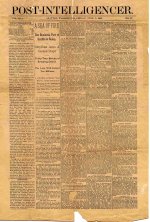
With one (wrong guy was blamed) or two minor corrections,
this is still your official version of what happened that day.
Short summary: I do not believe it was possible in 1889-90 for Seattle to pull this off. That said, I do not know where all the buildings came from, or when. May be they dug them out during the Great Seattle Regrade. Or may be we need to ask San Francisco.
P.S. At least the Fire in Seattle was started by a human. Chicago had to settle for a cow.
UPDATE: Seattle is not alone, there were hundreds of cities which suffered a very similar fate: Urban Fire verdict: global attack on our civilization or incompetency?


